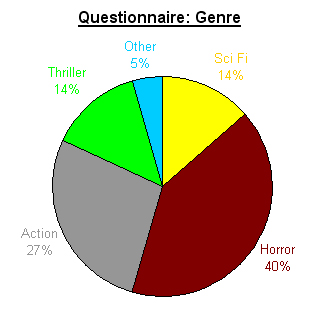- The Props are really exceptional. They create a realistic picture and a more dramatic effect/professional look. They got a huge 8.4% average rating in our questionnaire (the highest of all key areas)
- The element of mystery is also important, this invites the audience to predict the future/what is attacking all of these locals. It also allows the reader to look forward to discovering the cause of all of this mystery
- The violence is another appealing factor, particularly due to the fact that our target audience is males, therefore blood (cuts) and explosions are always exciting. The gun shot to the half-dead body leading to a bloody head explosion is mentioned by almost all viewers and is one of our Unique Selling Points
- The soundtrack/sound effects used are also significant as the audience empathises with the poor situation everyone is in and it adds to the tension and drama which are intelligently illustrated
- The washed-out effect used by our lighting is fantastic. It gives a dull, mysterious and interesting look, much like Misfits and it also helps draw emotion from the audience
- The use of younger actors could also appeal to the core audience as they are able to empathise with the characters
Marketing
To gain the attention of the audience, we used two advertising techniques:
- We used a Facebook event to invite all of our friends (who make up the core audience) to preview our screening
- We also placed posters around the school. These were placed below another group's poster as we decided to have a symbiotic relationship to draw a larger audience and also advertise together
- We have posted the sequence on Youtube in order to recieve more feedback and get a larger/broader audience appeal/reach
The Screening
The Screening went very successfully. We managed to attract over sixty attendees and they were all very enthusiastic towards our project and interested in offering honest feedback.
A video of the screening process
An excel spreadsheet of our questionnaire results (click for full-size)
Our target audience are 15-25 year old males and this became clear due to our questionnaire results. The average rating (shown in blue) from our male audience was a huge 8.6/10, whereas the average rating (shown in red) from our female audience was 7.4/10. This shows a clear difference in appeal as although both genders enjoyed the sequence, males (our core audience) illustrate a greater interest in comparison to females (our tertiary audience).
Example filled in
questionnaire:
The pie chart illustrates that most of the audience labelled our sequence as a Horror Genre. We were pleased to see that all of our ideas were reflected in our feedback as the actual genre is Horror/Action and 5 out of 21 members (we split the questionnaires between our group and I got 21) chose that our genre was Horror/Action and this is great as all of our ideas/inputs are realised by our audience



















